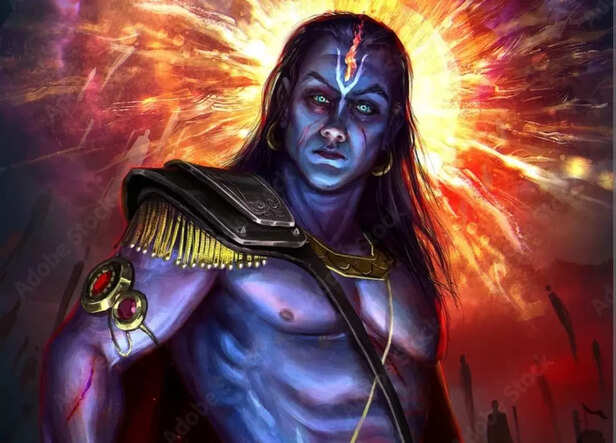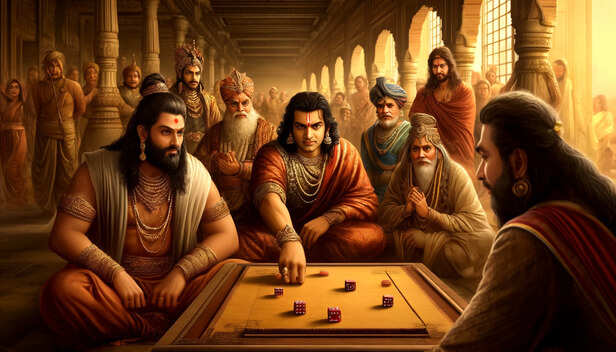These 4 Dark Corners Are Where Kaliyug Lives—As Revealed in the Bhagavad Purana
Ankit Gupta | May 02, 2025, 13:00 IST
( Image credit : Timeslife )
It warns that while Dharma may be strong, its erosion begins in subtle ways—through greed, intoxication, violence, and lust. Kali Yuga is not just a chronological age; it is a psychological and spiritual condition, a descent into fragmentation and forgetfulness of the Self.
"Dharma is said to stand on four legs in Satya Yuga. With each passing yuga, one leg is lost. In Kali Yuga, it stands on just one, trembling and weak."
In the immense timeline of Sanatan Dharma, the progression of time is divided into four yugas: Satya, Treta, Dvapara, and Kali. Each age represents a moral and spiritual descent. With Satya Yuga embodying truth and righteousness, the cycle declines until it reaches its nadir in Kali Yuga—the age of ignorance, materialism, and vice. This dark era, which we are currently in, finds its roots in an episode woven into the narrative of the Mahabharata and the Kalki Purana.
It was on the ninth day of the Kurukshetra war, as arrows darkened the sky and brother fought brother, that the wheel of time turned again. Dvapara Yuga gave way to Kali Yuga. But as long as Lord Krishna was on Earth, the influence of Kali Yuga remained suppressed. Only upon His departure did the age begin to assert itself.

Following Lord Krishna's ascension, King Parikshit, grandson of Arjuna, ascended the throne of Hastinapura. Parikshit was a just and virtuous ruler, upholding Dharma in his realm. During one of his tours to inspect the kingdom, he encountered a disturbing scene: a bull with only one leg, bleeding and trembling, being tormented by a dark, vicious man. Beside him stood a helpless cow—symbolizing Mother Earth.
This brutal figure was Kali Purusha, the personification of the Kali Yuga.
King Parikshit, enraged at the assault on Dharma (the bull) and Bhumi Devi (the cow), drew his sword to destroy the evil. However, Kali Purusha fell at the king's feet, begging for sanctuary. He argued that his time had come according to cosmic law, and he needed a place to reside. Parikshit, knowing the scriptures and the nature of time, decided not to deny the age its due, but to limit its power.

In the Kalki Purana, the four places where Kali Yuga is allowed to reside are clearly defined. King Parikshit, in his wisdom, designated these abodes to limit Kali's influence:
Dyutam (Gambling and Betting)
Gambling promotes deceit, greed, and loss of rational judgment. It leads individuals away from dharma and breaks apart families, as was evident in the Mahabharata when the dice game destroyed the Pandavas' kingdom.
Pānam (Consumption of Alcohol and Intoxicants)
Alcohol and other intoxicants disconnect a person from their spiritual and moral compass. They induce tamasic (ignorant) behavior, hinder self-discipline, and invite sin.
Suvarnam (Gold and Unchecked Wealth)
Gold symbolizes material greed and pride. When wealth becomes the central pursuit of life, it leads to corruption, inequality, and a loss of spiritual purpose. Through gold, Kali subtly influences pride, dishonesty, and enmity.
Striyah (Illicit Sexual Relations and Prostitution)
Here, 'striyah' refers not to women themselves but to the indulgence in uncontrolled lust and sexual misconduct. Prostitution and the commodification of sexuality degrade the sanctity of human relationships and spiritual celibacy.
Among the four, the mention of gold as an abode gave Kali Purusha the strongest advantage. It became the gateway through which he could control the other three. Wealth fuels gambling, buys alcohol, and often underwrites the illicit sex trade. Through wealth, Kali could penetrate even righteous households and spiritual institutions.

As Kali took root in these four domains, Dharma—once a mighty bull with four legs: Satya (Truth), Daya (Compassion), Tapas (Austerity), and Shaucham (Purity)—began to falter. In Kali Yuga, only a shaky remnant of truth remains, and even that is subject to manipulation and deceit.
Yet, Kali Yuga Holds a Secret Grace
Though this age is marked by decline, the Kalki Purana and other scriptures also affirm a hidden boon. In Kali Yuga, even a small act of devotion bears immense fruit.
As the Bhagavata Purana says:
"Kaler dosha-nidhe rajan asti hy eko maha-gunah kirtanad eva krishnasya mukta-sangah param vrajet"
“O King, although Kali Yuga is an ocean of faults, there is one great quality in this age: simply by chanting the name of Krishna, one can be freed from material bondage and attain liberation.”
(Bhagavata Purana 12.3.51)
The story of King Parikshit and Kali Purusha is not merely a tale of the past. It is a mirror held up to our times. Gambling, alcohol, lust, and greed are not just vices—they are portals through which collective consciousness declines.
The Kalki Purana reveals this not to spread fear, but to awaken awareness. We must guard our minds, our families, and our society from these four abodes of Kali. And in the midst of this dark age, turn toward light—through remembrance, restraint, and devotion.
Even in Kali Yuga, the spark of divinity is within reach. All it takes is the will to walk away from these four doors of destruction and walk toward dharma, one step at a time.
The Turning Point of Time
It was on the ninth day of the Kurukshetra war, as arrows darkened the sky and brother fought brother, that the wheel of time turned again. Dvapara Yuga gave way to Kali Yuga. But as long as Lord Krishna was on Earth, the influence of Kali Yuga remained suppressed. Only upon His departure did the age begin to assert itself.
The Arrival of Kali Purush

Inevitable Dillema (Image Credit: Pexels)
( Image credit : Timeslife )
Following Lord Krishna's ascension, King Parikshit, grandson of Arjuna, ascended the throne of Hastinapura. Parikshit was a just and virtuous ruler, upholding Dharma in his realm. During one of his tours to inspect the kingdom, he encountered a disturbing scene: a bull with only one leg, bleeding and trembling, being tormented by a dark, vicious man. Beside him stood a helpless cow—symbolizing Mother Earth.
This brutal figure was Kali Purusha, the personification of the Kali Yuga.
King Parikshit, enraged at the assault on Dharma (the bull) and Bhumi Devi (the cow), drew his sword to destroy the evil. However, Kali Purusha fell at the king's feet, begging for sanctuary. He argued that his time had come according to cosmic law, and he needed a place to reside. Parikshit, knowing the scriptures and the nature of time, decided not to deny the age its due, but to limit its power.
The Four Abodes of Kali According to Kalki Purana

Image Credit: Freepik
( Image credit : Timeslife )
In the Kalki Purana, the four places where Kali Yuga is allowed to reside are clearly defined. King Parikshit, in his wisdom, designated these abodes to limit Kali's influence:
Dyutam (Gambling and Betting)
Gambling promotes deceit, greed, and loss of rational judgment. It leads individuals away from dharma and breaks apart families, as was evident in the Mahabharata when the dice game destroyed the Pandavas' kingdom.
Pānam (Consumption of Alcohol and Intoxicants)
Alcohol and other intoxicants disconnect a person from their spiritual and moral compass. They induce tamasic (ignorant) behavior, hinder self-discipline, and invite sin.
Suvarnam (Gold and Unchecked Wealth)
Gold symbolizes material greed and pride. When wealth becomes the central pursuit of life, it leads to corruption, inequality, and a loss of spiritual purpose. Through gold, Kali subtly influences pride, dishonesty, and enmity.
Striyah (Illicit Sexual Relations and Prostitution)
Here, 'striyah' refers not to women themselves but to the indulgence in uncontrolled lust and sexual misconduct. Prostitution and the commodification of sexuality degrade the sanctity of human relationships and spiritual celibacy.
Gold – The Gateway to the Other Three
The Fall of Dharma

Image Credit: Freepik
( Image credit : Timeslife )
As Kali took root in these four domains, Dharma—once a mighty bull with four legs: Satya (Truth), Daya (Compassion), Tapas (Austerity), and Shaucham (Purity)—began to falter. In Kali Yuga, only a shaky remnant of truth remains, and even that is subject to manipulation and deceit.
Yet, Kali Yuga Holds a Secret Grace
Though this age is marked by decline, the Kalki Purana and other scriptures also affirm a hidden boon. In Kali Yuga, even a small act of devotion bears immense fruit.
As the Bhagavata Purana says:
"Kaler dosha-nidhe rajan asti hy eko maha-gunah kirtanad eva krishnasya mukta-sangah param vrajet"
“O King, although Kali Yuga is an ocean of faults, there is one great quality in this age: simply by chanting the name of Krishna, one can be freed from material bondage and attain liberation.”
(Bhagavata Purana 12.3.51)
A Call to Awareness
The Kalki Purana reveals this not to spread fear, but to awaken awareness. We must guard our minds, our families, and our society from these four abodes of Kali. And in the midst of this dark age, turn toward light—through remembrance, restraint, and devotion.
Even in Kali Yuga, the spark of divinity is within reach. All it takes is the will to walk away from these four doors of destruction and walk toward dharma, one step at a time.
